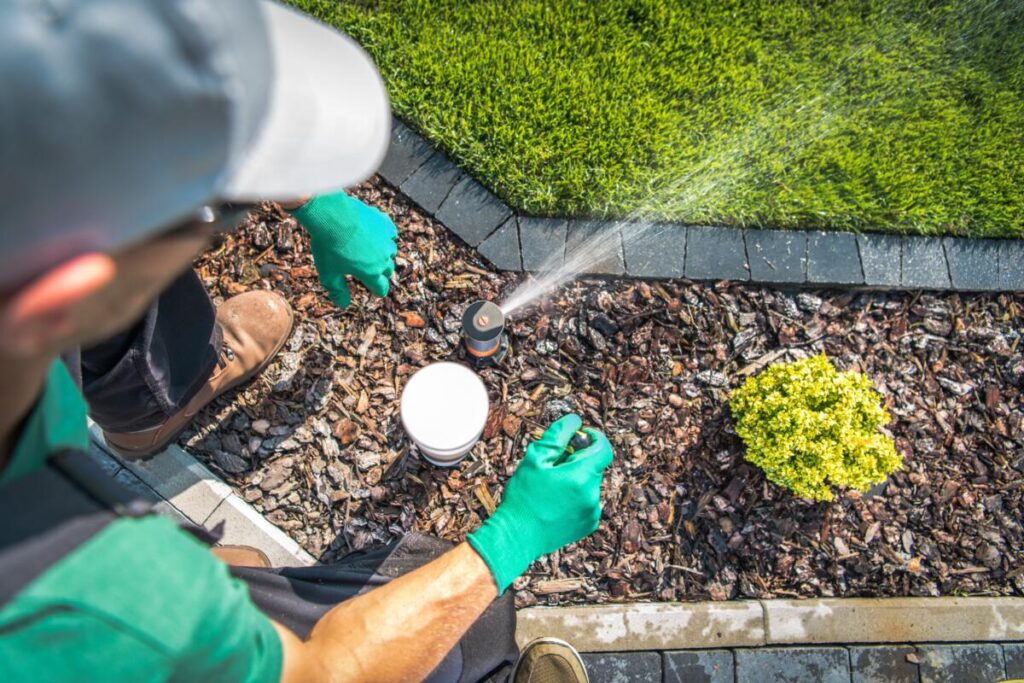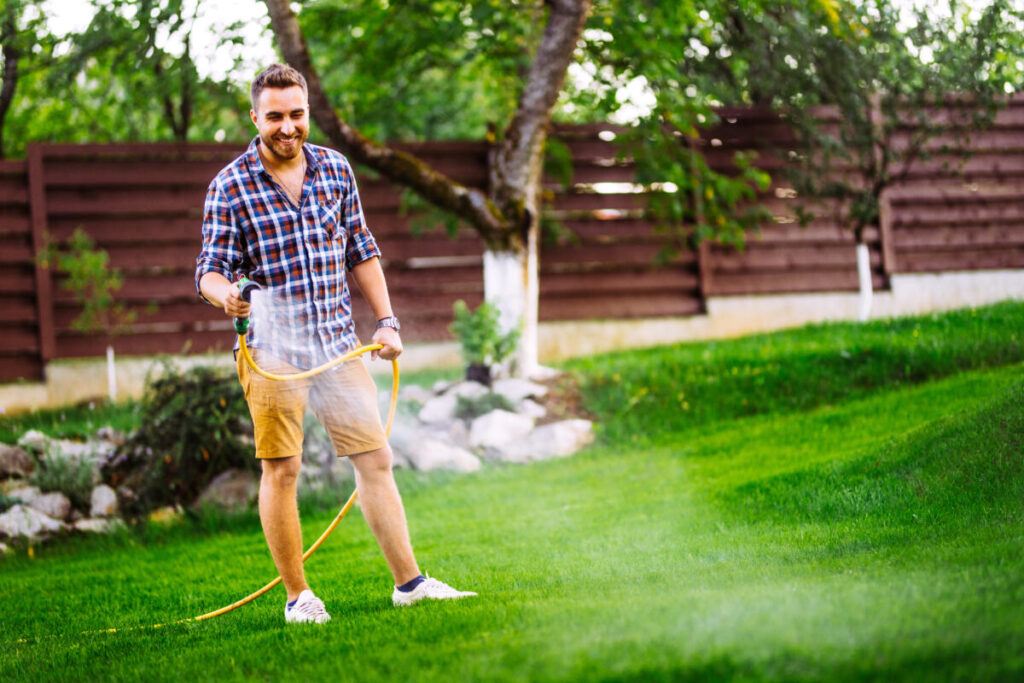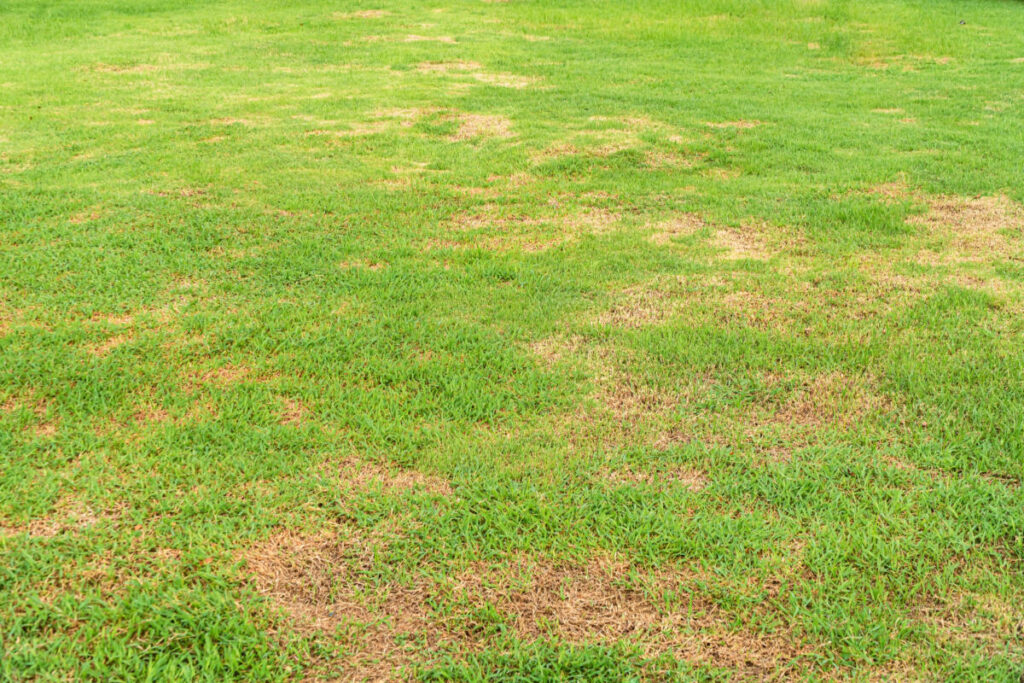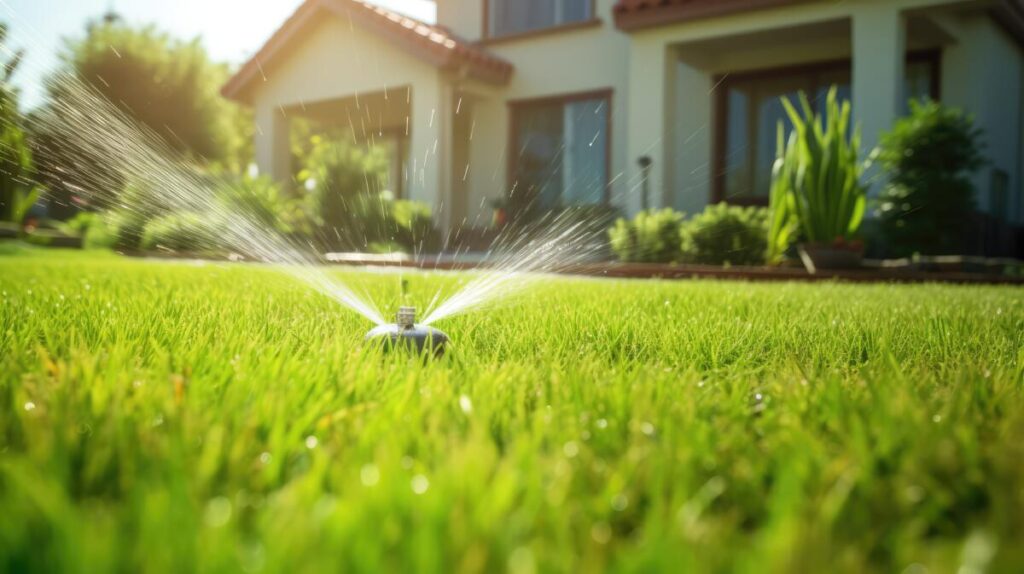Are you tired of staring at a dull, lifeless lawn? Do you wish your grass were greener and more vibrant? The secret to a healthy lawn lies in knowing the best time and technique to water the lawn. In this blog, we’ll reveal the optimal time to water your lawn, explore the unique watering needs of different grass types, and discuss efficient and effective watering techniques. Get ready to transform your lawn into an outdoor oasis that’s the envy of the neighborhood!
Key Takeaways
Water your lawn in the early morning for optimal hydration and to reduce water waste.
Understand your grass type’s unique watering needs to create a customized routine for a healthy, vibrant lawn.
Monitor soil moisture levels and use efficient techniques like sprinkler systems or irrigation options for healthier, greener growth!
Unlocking the Ideal Time to Water Your Lawn
A well-watered lawn is the foundation of a lush, green landscape. So when is the optimal time to water your lawn? The answer is early morning, ideally before 10 am.
Watering in the morning hours ensures that your lawn gets the hydration it needs to stay healthy and beautiful, and the grass roots are well-nourished. This timing also allows the water to be absorbed before the midday heat, reducing water waste due to evaporation.
Following lawn watering tips and times can also help in conserving water. Here are some things to keep in mind:
Water your lawn between 10 p.m. and 6 a.m. This allows the soil to stay consistently moist.
Water your mature lawn one to three times per week.
Avoid overwatering, as it can lead to weak roots and cause your lawn to struggle when water is scarce.
Avoid underwatering, as it can result in dry, cracked soil and wilted grass.
By following these tips, you can ensure that your lawn stays healthy while conserving water and taking into account your lawn’s square footage.
Benefits of Early Morning Watering
The benefits of early morning lawn watering go beyond water conservation. During these hours, the cooler temperatures and lack of wind help reduce water evaporation, which is especially important when you’re trying to establish new grass seeds. This means that more water will be absorbed by the roots, helping to maintain moisture throughout the day.
Moreover, early morning watering lowers the risk of water being blown away by the wind, preserves water, and decreases the chances of fungal diseases. So, not only are you saving water, but you’re also ensuring that your lawn stays healthy and vibrant.
Drawbacks of Midday and Nighttime Watering
Watering your lawn during midday or nighttime might seem convenient if you work in the mornings, but it can actually do more harm than good. Mid-afternoon is the worst time to water your lawn to ensure the most efficient use of water and avoid water loss through evaporation. The scorching sun and high temperatures can cause much of the water to evaporate before it reaches the grass roots, making it difficult to provide adequate moisture to the entire lawn.
At night, watering your grass can put your lawn at risk of developing fungus and other diseases due to the water sitting on the blades of grass overnight. Watering your lawn in the early morning helps avoid these issues, thus maintaining a healthier and greener lawn.
Grass Types and Their Watering Needs

Your lawn’s watering needs can vary depending on the grass type. Grasses can be broadly classified into two main categories: cool-season and warm-season. Each type of grass has its own characteristics and growth cycles. Cool-season grasses typically require more water than warm-season grasses due to their higher evapotranspiration rates. On the other hand, warm-season grasses have lower water requirements and can tolerate drier conditions.
The soil temperature, which plays a pivotal role in the growth of these grasses, should be considered when setting watering schedules. Understanding your specific grass type’s unique watering needs allows you to customize your watering routine for a healthy, vibrant lawn.
Cool-Season Grasses
Cool-season grasses, include:
Kentucky bluegrass
Perennial ryegrass
Fine fescue
Tall fescue
These types are perfect for maintaining a green lawn. They require about 1 inch of water per week from rainfall or irrigation to stay healthy and green. Due to their shallower root system, these grasses need more regular watering to maintain moisture levels in the soil.
To ensure cool-season grasses get the nutrients they need to thrive, it’s best to water them up to three times each week. This helps the roots get the nourishment they require to flourish. Providing an adequate amount of water helps keep your cool-season grasses healthy and hydrated.
Warm-Season Grasses
Warm-season grasses have different watering needs, such as:
Bahia grass
Bermuda grass
Centipede grass
St. Augustine grass
Zoysia grass
These grasses are more resilient to drought, so you don’t have to water them as often. For optimal results, it is recommended to water warm-season grasses in the morning, before 10 a.m., once or twice per week, for about 25 to 30 minutes each time.
Understanding the unique watering needs of warm-season grasses and tailoring your watering schedule to match helps maintain a healthy and attractive lawn year-round. Additionally, monitoring soil moisture levels and adapting your watering routine to your warm-season grasses’ specific needs is vital.
Factors Influencing Lawn Watering Frequency and Amount
Several factors can influence how often and how much you should water your lawn, such as:
The type of grass
The age of the grass
The type of soil
Climate
Temperature fluctuations
Sunlight duration
Weather patterns
Local climate
Rainfall amounts
Understanding these varying factors and tailoring your watering schedule to them can help your lawn receive the right amount of water it needs to stay healthy and grow properly.
Climate Considerations
The climate in your area can greatly impact your lawn’s watering needs. In hot and dry climates, lawns may require more water to stay healthy and attractive. Meanwhile, in cooler and wetter climates, the lawn may need less frequent watering. You can reach out to a local landscaping professional for their expertise.
In conditions of low humidity, water evaporates more quickly, so you may need to water your lawn more often. On the other hand, in high humidity, water evaporates more slowly, so you can reduce the frequency of watering. Consideration of your area’s climate will help ensure an optimal care plan for your lawn.
Soil Type Differences
The type of soil in your lawn can also have a significant impact on how often and how much you need to water. Sandy soils, for example, require more frequent watering than clay soils, as they don’t retain moisture as well. Understanding the type of soil in your lawn can help you determine the ideal watering schedule for your grass.
You can find different types of soil in home lawns, including:
Sandy soil
Silty soil
Clay soil
Loamy soil
All of these types of soil are great for growing a lush and healthy lawn. Testing your soil and tailoring your watering schedule to its specific needs ensures your lawn receives the right amount of water to stay healthy.
Efficient and Effective Lawn Watering Techniques

Adopting efficient and effective lawn watering techniques is key to maintaining a green and healthy lawn. With the right tools and techniques, you can ensure that your lawn gets the hydration it needs without wasting water. This not only benefits your lawn but also conserves water and saves you money on your water bill.
This section will delve into different sprinkler systems, irrigation options, and techniques for measuring water usage. Implementing these techniques can optimize your lawn watering routine, keeping your lawn at its best.
Sprinkler Systems and Irrigation Options
There are several types of sprinkler systems and irrigation options available for maintaining a healthy lawn, such as:
Stationary sprinklers
Rotary sprinklers
Oscillating sprinklers
Pulsating sprinklers
Traveling sprinklers
Impact sprinklers
Inground sprinkler systems
Misting sprinklers
These systems can be manual or automated, providing the right amount of water at the right time to promote healthier and greener lawns.
Choosing the right irrigation option for your lawn depends on your specific needs, lawn size, and landscape. A sprinkler system offers great coverage but may use more water than other options like drip irrigation systems, which are highly efficient and promote deep root growth for healthier lawns.
Measuring and Monitoring Water Usage
Measuring and monitoring your lawn’s water usage is essential for preventing overwatering and underwatering, which promotes healthy growth. To measure and monitor water usage effectively, you can use the tuna can sprinkler test to determine the amount of water applied. The tuna can test requires placing empty tuna cans in the areas of your lawn you are watering and stopping when they fill an inch to 1.5 inches full.
Calculating the cost of watering and monitoring weather conditions can also help you reach the goal of providing about one inch of water per week, including rainfall. Keeping track of your lawn’s water usage helps to ensure it receives the right amount of water, conserves resources, and maintains a healthy, beautiful landscape.
Signs of Overwatering and Underwatering
It’s vital to identify the signs of overwatering and underwatering to maintain a healthy lawn. Overwatering can deprive the roots of essential nutrients, while underwatering can lead to dried-out patches on your lawn. By identifying these signs and adjusting your watering routine accordingly, you can prevent lawn issues.
The following sections will discuss the symptoms of overwatered and underwatered lawns, and provide tips for adjusting your watering schedule to prevent further damage and keep your lawn healthy.
Identifying Overwatered Lawns
Overwatering your lawn can lead to several issues, such as:
Yellowing grass
Wilting or drooping grass
Spongy or squishy soil
An abundance of weeds
Fungus or mold growth
Root rot
These signs indicate that your lawn may be receiving too much water, which can harm its overall health and appearance.
Preventing overwatering requires:
Watering your lawn only as needed
Monitoring the soil moisture levels and adjusting your watering schedule accordingly
Using a rain gauge to measure the amount of rainfall and adjusting your watering schedule based on this information
Taking these steps can help prevent overwatering your lawn.
Recognizing Underwatered Lawns

Underwatering your lawn can result in the following signs:
Discoloration of the grass blades
Dry soil
Slow growth
Wilting or yellowing of the grass
Recognizing these signs can help you determine if your lawn needs more water, allowing you to adjust your watering schedule accordingly.
To bring an underwatered lawn back to its vibrant state, you can take the following steps:
Water thoroughly to ensure the soil is adequately hydrated.
Fertilize the lawn to provide essential nutrients.
Remove dead grass to promote new growth.
Mow the lawn at the appropriate height to encourage healthy growth.
Rake the lawn to remove any debris or thatch. With proper care and watering, you can help a lawn recover from being underwatered within a few weeks.
Paying close attention to the signs of underwatering and addressing the issues as needed.
Summary
In conclusion, knowing the best time to water your lawn, understanding the unique watering needs of different grass types, and utilizing efficient watering techniques can make a significant difference in the health and appearance of your lawn.
By carefully monitoring your lawn’s water usage and adjusting your watering schedule based on factors such as climate and soil type, you can maintain a lush, green lawn that’s the envy of the neighborhood. So, grab your watering can, set up your sprinklers, and take the first step towards a healthier, greener lawn today!
Frequently Asked Questions
Is it better to water grass at night or in the morning?
Watering your lawn early in the morning is the best choice; it ensures that the water won’t evaporate too quickly, unlike when watering during the day or at night.
How many minutes a day should I water my lawn?
To ensure your lawn receives adequate hydration, water it for 20 minutes, 3 times a week. This will provide approximately one inch of water per week to keep your lawn looking its best.
Should you water grass every day when it’s hot?
Watering your grass every day when it’s hot is not recommended. Instead, water your lawn deeply three times a week at dawn or early evening and aim for 1-1.5 inches of water each week. Test your sprinkler system to ensure even watering.
What is the best time to run sprinklers?
Early morning is the best time to water your lawn – from 4am to 8am. This ensures that the moisture has enough time to be absorbed deep in the roots to promote healthy growth, without creating an environment where fungus and other problems can easily manifest.
How do the watering needs of cool-season and warm-season grasses differ?
Cool-season grasses require more frequent watering than warm-season grasses, as they have higher evapotranspiration rates and shallower root systems.


